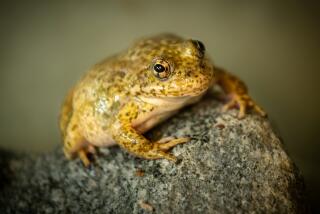Builder Says Project Won’t Harm Rare Species
The massive Ahmanson Ranch housing project can be built on the habitat of rare species without harming a threatened frog or a flower once believed extinct, according to developer Washington Mutual Inc.
The firm recently made the assertion in a draft conservation plan filed with Ventura County in a bid to avoid delays in the 3,050-home project.
The development, on the east Ventura County line, has become the focus of controversy. Ventura County has approved the plans, while Los Angeles County has challenged the project because of the impact on traffic and other public services.
Five of the 16 “key” habitat areas of the spineflower would be destroyed under the plan, according to Washington Mutual.
The draft plan is preliminary and is subject to review and approval by Ventura County, the state Department of Fish and Game and the U.S. Fish and Wildlife Service.
Earlier this week, Ventura County officials rejected requests for a new environmental study, and instead approved Washington Mutual’s request to prepare a supplemental environmental review to update a 1992 report. That action was prompted in part by last year’s discovery of the two species on Ahmanson Ranch land. The follow-up study will also examine the conservation measures for the spineflower and red-legged frog.
Opponents, such as Rep. Brad Sherman (D-Sherman Oaks) and the city of Calabasas, contended Friday the draft fails to protect the endangered species.
But a Washington Mutual official said the project could be built with protection for both species.
“I think these conservation measures that will be developed in cooperation with the [state and federal] agencies will allow [development] to occur in a very safe manner,” said Guy Gniadek, project manager and vice president of Ahmanson Land Co. “We expect there to be additional questions that will add to the science and biology for both species.”
This year, scientists identified 1.4 million spineflowers, compared to the 23,000 plants found last year, Gniadek said. More than 90% of the spineflower habitat and individual plants would be preserved under Ahmanson’s conservation plan, he said.
Open Space Includes ‘Core Frog Habitat’
A population of about 50 red-legged frogs has been identified in East Las Virgenes Creek, which runs east-to-west through the development and joins Las Virgenes Creek on the western boundary of the property.
A “core frog habitat” zone of 12 acres includes seven known frog pools that lie within the development’s open space areas, adjacent to a planned golf course.
Sherman, a vocal opponent of the project, had unsuccessfully lobbied state and federal agencies for an independent scientific panel to help develop a preservation plan for the frog and flower. Sherman was also unable to convince Ventura County to pursue a new environmental study instead of the less comprehensive supplemental report.
“We are disappointed that Ahmanson has decided not to be more forthcoming with information regarding the project,” said Susan Little, Sherman’s environmental deputy. “We are very concerned that the public hasn’t had more access to the decision-making process, especially given the fact that the project will have such a tremendous regional impact.”
Katherine Stone, special land use counsel for the city of Calabasas, which opposes the project, said the draft measures don’t offer enough protection for the two rare species.
The buffer areas are 200 feet, “but Fish and Game says buffers should be a minimum of 350 to 600 feet,” she said.
Stone also was concerned that Laskey Mesa, which “is the best place to preserve” the spineflower, will be developed with homes. “And that’s what this argument is all about. If we left it alone we would see more blooming on Laskey Mesa in the next couple of years.”
Stone said the frogs also need much more study. The frog has been found in a section of Ahmanson Ranch that won’t be developed for several years
Proposal Includes Road, Water Measures
The draft proposal recently filed with the Ventura County Planning Department outlines several potential measures, including:
* Adjusting the roads on Laskey Mesa, where many of the spineflowers are located, and realigning roads that affect East Las Virgenes Creek, where the frog has been found.
* Adjusting grading of project land near spineflower locations.
* Designing storm water drainage and water flows that won’t adversely affect spineflower and frog preserve areas.
* Monitoring of water supply to frog areas and installation of a water supply line in the event frog pool water levels decline significantly.
* Monitoring of water quality in frog areas, including runoff from golf course basins.
* Installing fencing or other barriers to protect flower and frog preserve areas.
* Developing management and habitat monitoring plans for the frog and spineflower.
* Appointing an on-site monitor who will oversee construction on days when building occurs within 200 feet of spineflower preserve zones and within 300 feet of core frog areas.
* Additional spineflower reintroduction on non-Ahmanson Ranch land and a continued research of the species.
* Creation of breeding pools within East Las Virgenes Creek and the golf course.
More to Read
Sign up for Essential California
The most important California stories and recommendations in your inbox every morning.
You may occasionally receive promotional content from the Los Angeles Times.










